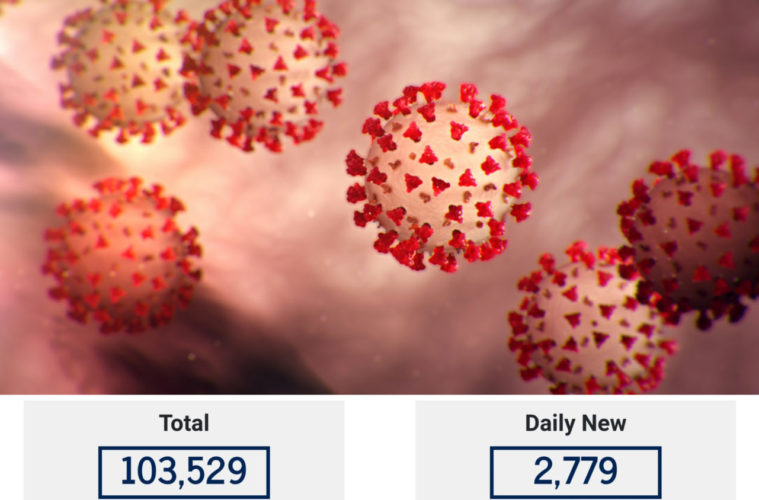As Angelenos prepare for Fourth of July weekend, Los Angeles County and the region face a spike in coronavirus cases, even as the COVID-19 fatality rate has slightly dipped.
Los Angeles County surpassed 100,000 positive COVID-19 cases this week, reaching a single-day high of 2,903 on Monday. Data show a cumulative 3 percent fatality rate, a slight decline from the 4 percent rate that was held for more than a month.
“Only deaths continue to go down and we know that’s a lagging indicator,” L.A. Mayor Eric Garcetti said while giving a COVID-19 update on Monday. “Sometimes, two, three, four weeks behind where we are today.”
COVID-19 Daily Update:
June 30, 2020
Cases: 2,779 (103,529 total)
Deaths: 45 (3,369 total)
Current Hospitalizations: 1,783 pic.twitter.com/sT2RMy2xaw— LA Public Health (@lapublichealth) June 30, 2020
Los Angeles County’s positive COVID-19 cases and deaths are recorded daily, and while patterns depend on the amount of testing, the number of deaths have not increased in the same way the positivity rate has over the last two weeks.
The fatality rate takes into account the amount of deaths compared to the positive cases and can be found on the Los Angeles Public Health COVID-19 Surveillance Dashboard, which keeps track of the county’s numbers with interactive charts and cumulative COVID-19 statistics.
The charts show a peak fatality rate of 10 percent in Los Angeles on May 17. On that day, there were 350 positive cases and 35 deaths.
That fatality rate has gradually decreased in the weeks since. Even as the county saw a single-day record 2,903 positive cases, there were 22 deaths for a less than 1 percent fatality rate.
Cumulatively, the fatality rate was at its highest from April 16 through June 21, with a 4 percent fatality rate. That rate fell to 3 percent in the following seven days and remained, as of the time of this writing.
Spike Will Test Hospitals
While deaths have not been ignored, L.A. County’s reopening phases have mostly focused on positivity rates and hospitalizations. More than 1 million people have been tested and the cumulative positivity rate has increased from 8 percent to 9 percent.
The positivity rates and hospitalizations are the focus because of the potential to overwhelm the state’s hospital capacity and exhaust resources if a surge were to occur. Currently, Garcetti has confirmed a 27 percent increase in Los Angeles hospitalizations over the last two weeks.
“We’re also very closely monitoring our hospital capacity, because that’s what we are fighting against,” Garcetti said. “Making sure that our medical workers and our medical facilities are not overwhelmed, so that we don’t lose more lives with front line workers, so that we have the capacity to save lives if people have bad cases of COVID-19.”
The effects are starting to be felt in different counties already, as hospitalizations have increased 43 percent statewide in the last two weeks. “We have already seen the impact of hospitals filling up with a significant number of patients with COVID-19,” Brandon Brown, associate professor at U.C. Riverside School of Medicine, told L.A. Weekly.
It’s a trend with potentially fatal knock-on effects. “People are being asked to delay routine medical care visits and voluntary surgeries,” Brown said, iterating that, in the case of Riverside County, nearly 100 percent of ICU beds have been filled. “This delay in seeking new and routine medical care can have significant negative impacts in the near future, with the other top causes of death like heart disease, cancer, diabetes and hypertension.”
The state of California has 73,867 beds currently available throughout all of its hospitals, with 42,895 being used and 4,776 of them occupied by COVID-19 patients. Governor Gavin Newsom stated there are alternative care sites, consisting of convention centers and other stadiums around the state, which can be activated if hospital capacities are exhausted.
“All these months, when we did the stay-at-home order, we didn’t sit on our hands,” Newsom said Monday. “We worked aggressively to not only engage with our county health officials, but also to engage them with purpose and intention. That included that we had a health care delivery system that included alternative test sites, included hospital beds, and plans, protocols and procedures.”
#COVID19 is on the rise.
We flattened the curve once, we can do it again.
We can crush this pandemic. We can get past this. But we have to be tougher and we have to do it TOGETHER.
Wear your mask. Practice physical distancing. Do your part.
Your actions will save lives.
— Gavin Newsom (@GavinNewsom) June 30, 2020
Reopenings Stall, May Potentially Reverse
With a 43 percent rise in hospitalizations statewide, Newsom continued to ask Californians to wear face coverings and observe social distancing, as he began an approach called the “dimmer switch,” where businesses revert back to a closed state, depending on their county’s COVID-19 data.
The switch was first activated Sunday, as several counties, including Los Angeles, were ordered to shut down bars. L.A. County Public Health Director Barbara Ferrer attributed the mandate to “community spread” of COVID-19 and lax compliance to safety regulations.
“There are a number of businesses and individuals who have not followed the directives and they’ve gone back to living as if COVID-19 is not in our community,” Ferrer explained. It was reported that 49 percent of bars did not follow physical distancing protocols and 53 percent did not have employees wearing face coverings.
While the Santa Monica Pier partially reopened Friday, the L.A. County Department of Health announced the closure of beaches and a ban on fireworks shows from midnight, Friday, to 5 a.m., Monday.
Advertising disclosure: We may receive compensation for some of the links in our stories. Thank you for supporting LA Weekly and our advertisers.

